Alloy
An editor has performed a search and found thatsufficient sources existto establish the subject'snotability.(July 2024) |
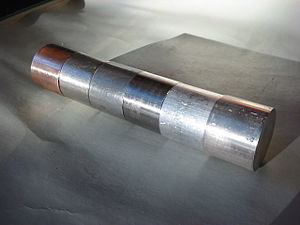
Analloyis amixtureofchemical elementsof which in most cases at least one is ametallicelement, although it is also sometimes used for mixtures of elements; herein onlymetallic alloysare described. Most alloys are metallic and show goodelectrical conductivity,ductility,opacity,andluster,and may have properties that differ from those of the pure elements such as increased strength or hardness. In some cases, an alloy may reduce the overall cost of the material while preserving important properties. In other cases, the mixture imparts synergistic properties such as corrosion resistance or mechanical strength.
In an alloy, the atoms are joined bymetallic bondingrather than bycovalent bondstypically found in chemical compounds.[1]The alloy constituents are usually measured by mass percentage for practical applications, and inatomic fractionfor basic science studies. Alloys are usually classified as substitutional orinterstitial alloys,depending on the atomic arrangement that forms the alloy. They can be further classified as homogeneous (consisting of a single phase), or heterogeneous (consisting of two or more phases) orintermetallic.An alloy may be asolid solutionof metal elements (a single phase, where all metallic grains (crystals) are of the same composition) or amixtureof metallic phases (two or more solutions, forming amicrostructureof different crystals within the metal).
Examples of alloys includered gold(goldandcopper),white gold(gold andsilver),sterling silver(silver and copper),steelorsilicon steel(ironwith non-metalliccarbonorsiliconrespectively),solder,brass,pewter,duralumin,bronze,andamalgams.
Alloys are used in a wide variety of applications, from the steel alloys, used in everything from buildings to automobiles to surgical tools, to exotictitaniumalloys used in the aerospace industry, to beryllium-copper alloys for non-sparking tools.
Characteristics
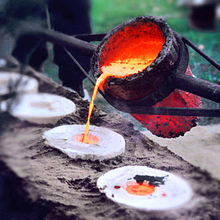
An alloy is a mixture ofchemical elements,which forms an impure substance (admixture) that retains the characteristics of a metal. An alloy is distinct from an impure metal in that, with an alloy, the added elements are well controlled to produce desirable properties, while impure metals such aswrought ironare less controlled, but are often considered useful. Alloys are made by mi xing two or more elements, at least one of which is a metal. This is usually called the primary metal or the base metal, and the name of this metal may also be the name of the alloy. The other constituents may or may not be metals but, when mixed with the molten base, they will besolubleand dissolve into the mixture. The mechanical properties of alloys will often be quite different from those of its individual constituents. A metal that is normally very soft (malleable), such asaluminium,can be altered by alloying it with another soft metal, such ascopper.Although both metals are very soft andductile,the resultingaluminium alloywill have much greaterstrength.Adding a small amount of non-metalliccarbontoirontrades its great ductility for the greater strength of an alloy called steel. Due to its very-high strength, but still substantialtoughness,and its ability to be greatly altered byheat treatment,steel is one of the most useful and common alloys in modern use. By addingchromiumto steel, its resistance tocorrosioncan be enhanced, creatingstainless steel,while addingsiliconwill alter its electrical characteristics, producingsilicon steel.

Like oil and water, a molten metal may not always mix with another element. For example, pure iron is almost completelyinsolublewith copper. Even when the constituents are soluble, each will usually have asaturation point,beyond which no more of the constituent can be added. Iron, for example, can hold a maximum of 6.67% carbon. Although the elements of an alloy usually must be soluble in theliquidstate, they may not always be soluble in thesolidstate. If the metals remain soluble when solid, the alloy forms asolid solution,becoming a homogeneous structure consisting of identical crystals, called aphase.If as the mixture cools the constituents become insoluble, they may separate to form two or more different types of crystals, creating a heterogeneousmicrostructureof different phases, some with more of one constituent than the other. However, in other alloys, the insoluble elements may not separate until after crystallization occurs. If cooled very quickly, they first crystallize as a homogeneous phase, but they aresupersaturatedwith the secondary constituents. As time passes, the atoms of these supersaturated alloys can separate from the crystal lattice, becoming more stable, and forming a second phase that serves to reinforce the crystals internally.

Some alloys, such aselectrum—an alloy ofsilverandgold—occur naturally. Meteorites are sometimes made of naturally occurring alloys of iron andnickel,but are not native to the Earth. One of the first alloys made by humans was bronze, which is a mixture of the metalstinand copper. Bronze was an extremely useful alloy to the ancients, because it is much stronger and harder than either of its components. Steel was another common alloy. However, in ancient times, it could only be created as an accidental byproduct from the heating of iron ore in fires (smelting) during the manufacture of iron. Other ancient alloys includepewter,brass andpig iron.In the modern age, steel can be created in many forms.Carbon steelcan be made by varying only the carbon content, producing soft alloys likemild steelor hard alloys likespring steel.Alloy steelscan be made by adding other elements, such aschromium,molybdenum,vanadiumornickel,resulting in alloys such ashigh-speed steelortool steel.Small amounts ofmanganeseare usually alloyed with most modern steels because of its ability to remove unwanted impurities, likephosphorus,sulfurandoxygen,which can have detrimental effects on the alloy. However, most alloys were not created until the 1900s, such as various aluminium,titanium,nickel,andmagnesium alloys.Some modernsuperalloys,such asincoloy,inconel, andhastelloy,may consist of a multitude of different elements.
An alloy is technically an impure metal, but when referring to alloys, the termimpuritiesusually denotes undesirable elements. Such impurities are introduced from the base metals and alloying elements, but are removed during processing. For instance, sulfur is a common impurity in steel. Sulfur combines readily with iron to formiron sulfide,which is very brittle, creating weak spots in the steel.[2]Lithium,sodiumandcalciumare common impurities in aluminium alloys, which can have adverse effects on thestructural integrityof castings. Conversely, otherwise pure-metals that contain unwanted impurities are often called "impure metals" and are not usually referred to as alloys. Oxygen, present in the air, readily combines with most metals to formmetal oxides;especially at higher temperatures encountered during alloying. Great care is often taken during the alloying process to remove excess impurities, usingfluxes,chemical additives, or other methods ofextractive metallurgy.[3]
Theory
Alloying a metal is done by combining it with one or more other elements. The most common and oldest alloying process is performed by heating the base metal beyond itsmelting pointand then dissolving the solutes into the molten liquid, which may be possible even if the melting point of the solute is far greater than that of the base. For example, in its liquid state, titanium is a very strong solvent capable of dissolving most metals and elements. In addition, it readily absorbs gases like oxygen and burns in the presence of nitrogen. This increases the chance of contamination from any contacting surface, and so must be melted in vacuum induction-heating and special, water-cooled, coppercrucibles.[4]However, some metals and solutes, such as iron and carbon, have very high melting-points and were impossible for ancient people to melt. Thus, alloying (in particular, interstitial alloying) may also be performed with one or more constituents in a gaseous state, such as found in ablast furnaceto make pig iron (liquid-gas),nitriding,carbonitridingor other forms ofcase hardening(solid-gas), or thecementation processused to makeblister steel(solid-gas). It may also be done with one, more, or all of the constituents in the solid state, such as found in ancient methods ofpattern welding(solid-solid),shear steel(solid-solid), orcrucible steelproduction (solid-liquid), mi xing the elements via solid-statediffusion.
By adding another element to a metal, differences in the size of the atoms create internal stresses in the lattice of the metallic crystals; stresses that often enhance its properties. For example, the combination of carbon with iron produces steel, which is stronger than iron, its primary element. Theelectricalandthermal conductivityof alloys is usually lower than that of the pure metals. The physical properties, such asdensity,reactivity,Young's modulusof an alloy may not differ greatly from those of its base element, but engineering properties such astensile strength,[5]ductility, andshear strengthmay be substantially different from those of the constituent materials. This is sometimes a result of the sizes of theatomsin the alloy, because larger atoms exert a compressive force on neighboring atoms, and smaller atoms exert a tensile force on their neighbors, helping the alloy resist deformation. Sometimes alloys may exhibit marked differences in behavior even when small amounts of one element are present. For example, impurities in semiconductingferromagneticalloys lead to different properties, as first predicted by White, Hogan, Suhl, Tian Abrie and Nakamura.[6][7]
Unlike pure metals, most alloys do not have a singlemelting point,but a melting range during which the material is a mixture ofsolidandliquidphases (a slush). The temperature at which melting begins is called thesolidus,and the temperature when melting is just complete is called theliquidus.For many alloys there is a particular alloy proportion (in some cases more than one), called either aeutecticmixture or a peritectic composition, which gives the alloy a unique and low melting point, and no liquid/solid slush transition.
Heat treatment
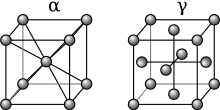

Alloying elements are added to a base metal, to inducehardness,toughness,ductility, or other desired properties. Most metals and alloys can bework hardenedby creating defects in their crystal structure. These defects are created duringplastic deformationby hammering, bending, extruding, et cetera, and are permanent unless the metal isrecrystallized.Otherwise, some alloys can also have their properties altered byheat treatment.Nearly all metals can be softened byannealing,which recrystallizes the alloy and repairs the defects, but not as many can be hardened by controlled heating and cooling. Many alloys of aluminium, copper,magnesium,titanium, and nickel can be strengthened to some degree by some method of heat treatment, but few respond to this to the same degree as does steel.[8]
The base metal iron of the iron-carbon alloy known as steel, undergoes a change in the arrangement (allotropy) of the atoms of its crystal matrix at a certain temperature (usually between 820 °C (1,500 °F) and 870 °C (1,600 °F), depending on carbon content). This allows the smaller carbon atoms to enter the interstices of the iron crystal. When thisdiffusionhappens, the carbon atoms are said to be insolutionin the iron, forming a particular single, homogeneous, crystalline phase calledaustenite.If the steel is cooled slowly, the carbon can diffuse out of the iron and it will gradually revert to its low temperature allotrope. During slow cooling, the carbon atoms will no longer be assolublewith the iron, and will be forced toprecipitateout of solution,nucleatinginto a more concentrated form of iron carbide (Fe3C) in the spaces between the pure iron crystals. The steel then becomes heterogeneous, as it is formed of two phases, the iron-carbon phase calledcementite(orcarbide), and pure ironferrite.Such a heat treatment produces a steel that is rather soft. If the steel is cooled quickly, however, the carbon atoms will not have time to diffuse and precipitate out as carbide, but will be trapped within the iron crystals. When rapidly cooled, adiffusionless (martensite) transformationoccurs, in which the carbon atoms become trapped in solution. This causes the iron crystals to deform as the crystal structure tries to change to its low temperature state, leaving those crystals very hard but much less ductile (more brittle).
While the high strength of steel results when diffusion and precipitation is prevented (forming martensite), most heat-treatable alloys areprecipitation hardeningalloys, that depend on the diffusion of alloying elements to achieve their strength. When heated to form a solution and then cooled quickly, these alloys become much softer than normal, during the diffusionless transformation, but then harden as they age. The solutes in these alloys will precipitate over time, formingintermetallicphases, which are difficult to discern from the base metal. Unlike steel, in which the solid solution separates into different crystal phases (carbide and ferrite), precipitation hardening alloys form different phases within the same crystal. These intermetallic alloys appear homogeneous in crystal structure, but tend to behave heterogeneously, becoming hard and somewhat brittle.[8]
In 1906,precipitation hardeningalloys were discovered byAlfred Wilm.Precipitation hardening alloys, such as certain alloys of aluminium, titanium, and copper, are heat-treatable alloys that soften whenquenched(cooled quickly), and then harden over time. Wilm had been searching for a way to harden aluminium alloys for use in machine-gun cartridge cases. Knowing that aluminium-copper alloys were heat-treatable to some degree, Wilm tried quenching a ternary alloy of aluminium, copper, and the addition of magnesium, but was initially disappointed with the results. However, when Wilm retested it the next day he discovered that the alloy increased in hardness when left to age at room temperature, and far exceeded his expectations. Although an explanation for the phenomenon was not provided until 1919,duraluminwas one of the first "age hardening" alloys used, becoming the primary building material for the firstZeppelins,and was soon followed by many others.[9]Because they often exhibit a combination of high strength and low weight, these alloys became widely used in many forms of industry, including the construction of modernaircraft.[10]
Mechanisms

When a molten metal is mixed with another substance, there are two mechanisms that can cause an alloy to form, calledatom exchangeand theinterstitial mechanism.The relative size of each element in the mix plays a primary role in determining which mechanism will occur. When the atoms are relatively similar in size, the atom exchange method usually happens, where some of the atoms composing the metallic crystals are substituted with atoms of the other constituent. This is called asubstitutional alloy.Examples of substitutional alloys include bronze and brass, in which some of the copper atoms are substituted with either tin or zinc atoms respectively.
In the case of the interstitial mechanism, one atom is usually much smaller than the other and can not successfully substitute for the other type of atom in the crystals of the base metal. Instead, the smaller atoms become trapped in theinterstitial sitesbetween the atoms of the crystal matrix. This is referred to as aninterstitial alloy.Steel is an example of an interstitial alloy, because the very small carbon atoms fit into interstices of the iron matrix.
Stainless steelis an example of a combination of interstitial and substitutional alloys, because the carbon atoms fit into the interstices, but some of the iron atoms are substituted by nickel and chromium atoms.[8]
History and examples
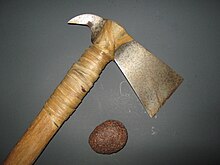
Meteoric iron
The use of alloys by humans started with the use ofmeteoric iron,a naturally occurring alloy of nickel and iron. It is the main constituent ofiron meteorites.As no metallurgic processes were used to separate iron from nickel, the alloy was used as it was.[11]Meteoric iron could be forged from a red heat to make objects such as tools, weapons, and nails. In many cultures it was shaped by cold hammering into knives and arrowheads. They were often used as anvils. Meteoric iron was very rare and valuable, and difficult for ancient people towork.[12]
Bronze and brass


Iron is usually found asiron oreon Earth, except for one deposit ofnative ironinGreenland,which was used by theInuit.[13]Native copper, however, was found worldwide, along with silver, gold, andplatinum,which were also used to make tools, jewelry, and other objects since Neolithic times. Copper was the hardest of these metals, and the most widely distributed. It became one of the most important metals to the ancients. Around 10,000 years ago in the highlands ofAnatolia(Turkey), humans learned tosmeltmetals such as copper andtinfromore.Around 2500 BC, people began alloying the two metals to form bronze, which was much harder than its ingredients. Tin was rare, however, being found mostly in Great Britain. In the Middle East, people began alloying copper withzincto form brass.[14]Ancient civilizations took into account the mixture and the various properties it produced, such ashardness,toughness and melting point, under various conditions oftemperatureandwork hardening,developing much of the information contained in modernalloy phase diagrams.[15]For example, arrowheads from the ChineseQin dynasty(around 200 BC) were often constructed with a hard bronze-head, but a softer bronze-tang, combining the alloys to prevent both dulling and breaking during use.[16]
Amalgams
Mercuryhas been smelted fromcinnabarfor thousands of years. Mercury dissolves many metals, such as gold, silver, and tin, to formamalgams(an alloy in a soft paste or liquid form at ambient temperature). Amalgams have been used since 200 BC in China forgildingobjects such asarmorandmirrorswith precious metals. The ancient Romans often used mercury-tin amalgams for gilding their armor. The amalgam was applied as a paste and then heated until the mercury vaporized, leaving the gold, silver, or tin behind.[17]Mercury was often used in mining, to extract precious metals like gold and silver from their ores.[18]
Precious metals
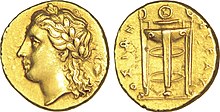
Many ancient civilizations alloyed metals for purely aesthetic purposes. In ancientEgyptandMycenae,gold was often alloyed with copper to produce red-gold, or iron to produce a bright burgundy-gold. Gold was often found alloyed with silver or other metals to produce various types ofcolored gold.These metals were also used to strengthen each other, for more practical purposes. Copper was often added to silver to makesterling silver,increasing its strength for use in dishes, silverware, and other practical items. Quite often, precious metals were alloyed with less valuable substances as a means to deceive buyers.[19]Around 250 BC,Archimedeswas commissioned by the King ofSyracuseto find a way to check the purity of the gold in a crown, leading to the famous bath-house shouting of "Eureka!" upon the discovery ofArchimedes' principle.[20]
Pewter
The termpewtercovers a variety of alloys consisting primarily of tin. As a pure metal, tin is much too soft to use for most practical purposes. However, during theBronze Age,tin was a rare metal in many parts of Europe and the Mediterranean, so it was often valued higher than gold. To make jewellery, cutlery, or other objects from tin, workers usually alloyed it with other metals to increase strength and hardness. These metals were typicallylead,antimony,bismuthor copper. These solutes were sometimes added individually in varying amounts, or added together, making a wide variety of objects, ranging from practical items such as dishes, surgical tools, candlesticks or funnels, to decorative items like ear rings and hair clips.
The earliest examples of pewter come from ancient Egypt, around 1450 BC. The use of pewter was widespread across Europe, from France to Norway and Britain (where most of the ancient tin was mined) to the Near East.[21]The alloy was also used in China and the Far East, arriving in Japan around 800 AD, where it was used for making objects like ceremonial vessels, tea canisters, or chalices used inshintoshrines.[22]
Iron

The first known smelting of iron began inAnatolia,around 1800 BC. Called thebloomery process,it produced very soft butductilewrought iron.By 800 BC, iron-making technology had spread to Europe, arriving in Japan around 700 AD.Pig iron,a very hard but brittle alloy of iron and carbon, was being produced inChinaas early as 1200 BC, but did not arrive in Europe until the Middle Ages. Pig iron has a lower melting point than iron, and was used for makingcast-iron.However, these metals found little practical use until the introduction ofcrucible steelaround 300 BC. These steels were of poor quality, and the introduction ofpattern welding,around the 1st century AD, sought to balance the extreme properties of the alloys by laminating them, to create a tougher metal. Around 700 AD, the Japanese began folding bloomery-steel and cast-iron in alternating layers to increase the strength of their swords, using clay fluxes to removeslagand impurities. This method ofJapanese swordsmithingproduced one of the purest steel-alloys of the ancient world.[15]
While the use of iron started to become more widespread around 1200 BC, mainly because of interruptions in the trade routes for tin, the metal was much softer than bronze. However, very small amounts of steel, (an alloy of iron and around 1% carbon), was always a byproduct of the bloomery process. The ability to modify the hardness of steel by heat treatment had been known since 1100 BC, and the rare material was valued for the manufacture of tools and weapons. Because the ancients could not produce temperatures high enough to melt iron fully, the production of steel in decent quantities did not occur until the introduction ofblister steelduring the Middle Ages. This method introduced carbon by heating wrought iron in charcoal for long periods of time, but the absorption of carbon in this manner is extremely slow thus the penetration was not very deep, so the alloy was not homogeneous. In 1740,Benjamin Huntsmanbegan melting blister steel in a crucible to even out the carbon content, creating the first process for the mass production oftool steel.Huntsman's process was used for manufacturing tool steel until the early 1900s.[23]
The introduction of the blast furnace to Europe in the Middle Ages meant that people could produce pig iron in much higher volumes than wrought iron. Because pig iron could be melted, people began to develop processes to reduce carbon in liquid pig iron to create steel.Puddlinghad been used in China since the first century, and was introduced in Europe during the 1700s, where molten pig iron was stirred while exposed to the air, to remove the carbon byoxidation.In 1858,Henry Bessemerdeveloped a process of steel-making by blowing hot air through liquid pig iron to reduce the carbon content. TheBessemer processled to the first large scale manufacture of steel.[23]
Steel is an alloy of iron and carbon, but the termalloy steelusually only refers to steels that contain other elements— likevanadium,molybdenum,orcobalt—in amounts sufficient to alter the properties of the base steel. Since ancient times, when steel was used primarily for tools and weapons, the methods of producing and working the metal were often closely guarded secrets. Even long after theAge of Enlightenment,the steel industry was very competitive and manufacturers went through great lengths to keep their processes confidential, resisting any attempts to scientifically analyze the material for fear it would reveal their methods. For example, the people ofSheffield,a center of steel production in England, were known to routinely bar visitors and tourists from entering town to deterindustrial espionage.Thus, almost no metallurgical information existed about steel until 1860. Because of this lack of understanding, steel was not generally considered an alloy until the decades between 1930 and 1970 (primarily due to the work of scientists likeWilliam Chandler Roberts-Austen,Adolf Martens,andEdgar Bain), so "alloy steel" became the popular term for ternary and quaternary steel-alloys.[24][25]
After Benjamin Huntsman developed his crucible steel in 1740, he began experimenting with the addition of elements likemanganese(in the form of a high-manganese pig-iron calledspiegeleisen), which helped remove impurities such as phosphorus and oxygen; a process adopted by Bessemer and still used in modern steels (albeit in concentrations low enough to still be considered carbon steel).[26]Afterward, many people began experimenting with various alloys of steel without much success. However, in 1882,Robert Hadfield,being a pioneer in steel metallurgy, took an interest and produced a steel alloy containing around 12% manganese. Calledmangalloy,it exhibited extreme hardness and toughness, becoming the first commercially viable alloy-steel.[27]Afterward, he created silicon steel, launching the search for other possible alloys of steel.[28]
Robert Forester Mushetfound that by addingtungstento steel it could produce a very hard edge that would resist losing its hardness at high temperatures. "R. Mushet's special steel" (RMS) became the firsthigh-speed steel.[29]Mushet's steel was quickly replaced bytungsten carbidesteel, developed by Taylor and White in 1900, in which they doubled the tungsten content and added small amounts of chromium and vanadium, producing a superior steel for use in lathes and machining tools. In 1903, theWright brothersused a chromium-nickel steel to make the crankshaft for their airplane engine, while in 1908Henry Fordbegan using vanadium steels for parts like crankshafts and valves in hisModel T Ford,due to their higher strength and resistance to high temperatures.[30]In 1912, the Krupp Ironworks in Germany developed a rust-resistant steel by adding 21% chromium and 7% nickel, producing the first stainless steel.[31]
Others
Due to their high reactivity, most metals were not discovered until the 19th century. A method for extracting aluminium frombauxitewas proposed byHumphry Davyin 1807, using anelectric arc.Although his attempts were unsuccessful, by 1855 the first sales of pure aluminium reached the market. However, asextractive metallurgywas still in its infancy, most aluminium extraction-processes produced unintended alloys contaminated with other elements found in the ore; the most abundant of which was copper. These aluminium-copper alloys (at the time termed "aluminum bronze" ) preceded pure aluminium, offering greater strength and hardness over the soft, pure metal, and to a slight degree were found to be heat treatable.[32]However, due to their softness and limited hardenability these alloys found little practical use, and were more of a novelty, until theWright brothersused an aluminium alloy to construct the first airplane engine in 1903.[30]During the time between 1865 and 1910, processes for extracting many other metals were discovered, such as chromium, vanadium, tungsten,iridium,cobalt,and molybdenum, and various alloys were developed.[33]
Prior to 1910, research mainly consisted of private individuals tinkering in their own laboratories. However, as the aircraft and automotive industries began growing, research into alloys became an industrial effort in the years following 1910, as newmagnesium alloyswere developed for pistons andwheelsin cars, andpot metalfor levers and knobs, and aluminium alloys developed forairframesandaircraft skinswere put into use.[30]The Doehler Die Casting Co. of Toledo, Ohio were known for the production ofBrastil,a high tensile corrosion resistant bronze alloy.[34][35]
See also
References
- ^Callister, W.D. "Materials Science and Engineering: An Introduction" 2007, 7th edition, John Wiley and Sons, Inc. New York, Section 4.3 and Chapter 9.
- ^Verhoeven, John D. (2007).Steel Metallurgy for the Non-metallurgist.ASM International. p. 56.ISBN978-1-61503-056-9.Archivedfrom the original on 2016-05-05.
- ^Davis, Joseph R. (1993)ASM Specialty Handbook: Aluminum and Aluminum Alloys.ASM International. p. 211.ISBN978-0-87170-496-2.
- ^Metals Handbook: Properties and selectionBy ASM International – ASM International 1978 Page 407
- ^Mills, Adelbert Phillo (1922)Materials of Construction: Their Manufacture and Properties,John Wiley & sons, inc, originally published by the University of Wisconsin, Madison
- ^Hogan, C. (1969). "Density of States of an Insulating Ferromagnetic Alloy".Physical Review.188(2): 870–874.Bibcode:1969PhRv..188..870H.doi:10.1103/PhysRev.188.870.
- ^Zhang, X.; Suhl, H. (1985). "Spin-wave-related period doublings and chaos under transverse pumping".Physical Review A.32(4): 2530–2533.Bibcode:1985PhRvA..32.2530Z.doi:10.1103/PhysRevA.32.2530.PMID9896377.
- ^abcDossett, Jon L.; Boyer, Howard E. (2006)Practical heat treating.ASM International. pp. 1–14.ISBN1-61503-110-3.
- ^Metallurgy for the Non-Metallurgistby Harry Chandler – ASM International 1998 Page 1—3
- ^Jacobs, M.H.Precipitation HardneningArchived2012-12-02 at theWayback Machine.University of Birmingham. TALAT Lecture 1204. slideshare.net
- ^Rickard, T.A. (1941). "The Use of Meteoric Iron".Journal of the Royal Anthropological Institute.71(1/2): 55–66.doi:10.2307/2844401.JSTOR2844401.
- ^Buchwald,pp. 13–22
- ^Buchwald,pp. 35–37
- ^Buchwald, pp. 39–41
- ^abSmith, Cyril (1960)History of metallography.MIT Press. pp. 2–4.ISBN0-262-69120-5.
- ^Emperor's Ghost ArmyArchived2017-11-01 at theWayback Machine.pbs.org. November 2014
- ^Rapp, George (2009)ArchaeomineralogyArchived2016-04-28 at theWayback Machine.Springer. p. 180.ISBN3-540-78593-0
- ^Miskimin, Harry A. (1977)The economy of later Renaissance Europe, 1460–1600Archived2016-05-05 at theWayback Machine.Cambridge University Press. p. 31.ISBN0-521-29208-5.
- ^Nicholson, Paul T. and Shaw, Ian (2000)Ancient Egyptian materials and technologyArchived2016-05-02 at theWayback Machine.Cambridge University Press. pp. 164–167.ISBN0-521-45257-0.
- ^Kay, Melvyn (2008)Practical HydraulicsArchived2016-06-03 at theWayback Machine.Taylor and Francis. p. 45.ISBN0-415-35115-4.
- ^Hull, Charles (1992)Pewter.Shire Publications. pp. 3–4;ISBN0-7478-0152-5
- ^Brinkley, Frank (1904)Japan and China: Japan, its history, arts, and literature.Oxford University. p. 317
- ^abRoberts, George Adam; Krauss, George; Kennedy, Richard and Kennedy, Richard L. (1998)Tool steelsArchived2016-04-24 at theWayback Machine.ASM International. pp. 2–3.ISBN0-87170-599-0.
- ^Sheffield Steel and America: A Century of Commercial and Technological IndependenceBy Geoffrey Tweedale – Cambridge University Press 1987 Page 57—62
- ^Experimental Techniques in Materials and MechanicsBy C. Suryanarayana – CRC Press 2011 p. 202
- ^Tool Steels, 5th EditionBy George Adam Roberts, Richard Kennedy, G. Krauss – ASM International 1998 p. 4
- ^Bramfitt, B.L. (2001).Metallographer's Guide: Practice and Procedures for Irons and Steels.ASM International. pp. 13–.ISBN978-1-61503-146-7.Archivedfrom the original on 2016-05-02.
- ^Sheffield Steel and America: A Century of Commercial and Technological IndependenceBy Geoffrey Tweedale – Cambridge University Press 1987 pp. 57—62
- ^Sheffield Steel and America: A Century of Commercial and Technological IndependenceBy Geoffrey Tweedale – Cambridge University Press 1987 pp. 66—68
- ^abcMetallurgy for the Non-Metallurgistby Harry Chandler – ASM International 1998 Page 3—5
- ^Sheffield Steel and America: A Century of Commercial and Technological IndependenceBy Geoffrey Tweedale – Cambridge University Press 1987 p. 75
- ^Aluminium: Its History, Occurrence, Properties, Metallurgy and Applicationsby Joseph William Richards – Henry Cairy Baird & Co 1887 Page 25—42
- ^Metallurgy: 1863–1963by W.H. Dennis – Routledge 2017
- ^https:// utoledo.edu/library/canaday/HTML_findingaids/MSS-202.html
- ^Woldman’s Engineering Alloys, 9th Edition 1936, American Society for Metals,ISBN978-0-87170-691-1
Bibliography
- Buchwald, Vagn Fabritius (2005).Iron and steel in ancient times.Det Kongelige Danske Videnskabernes Selskab.ISBN978-87-7304-308-0.
External links
- Roberts-Austen, William Chandler;Neville, Francis Henry (1911)..Encyclopædia Britannica(11th ed.).
- .The American Cyclopædia.1879.
